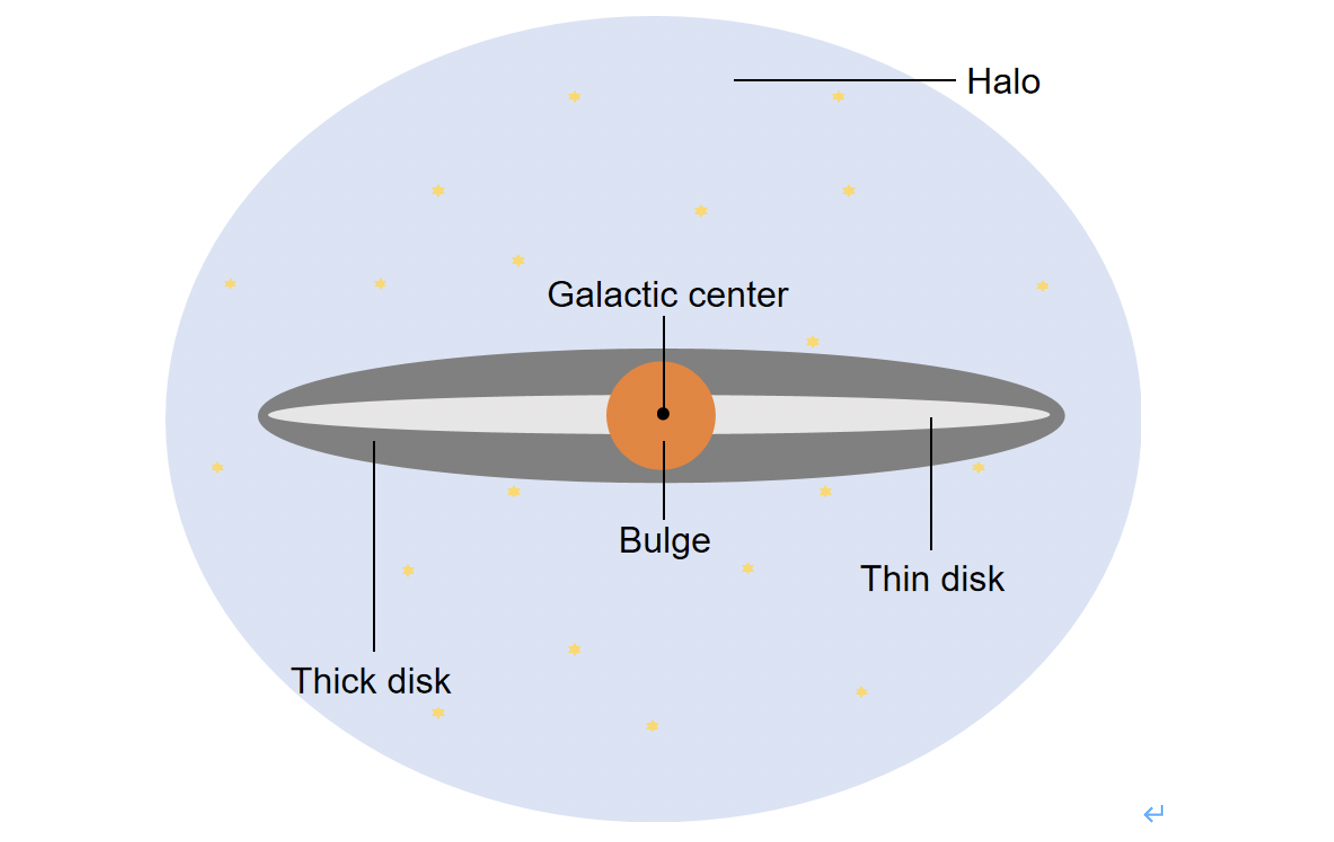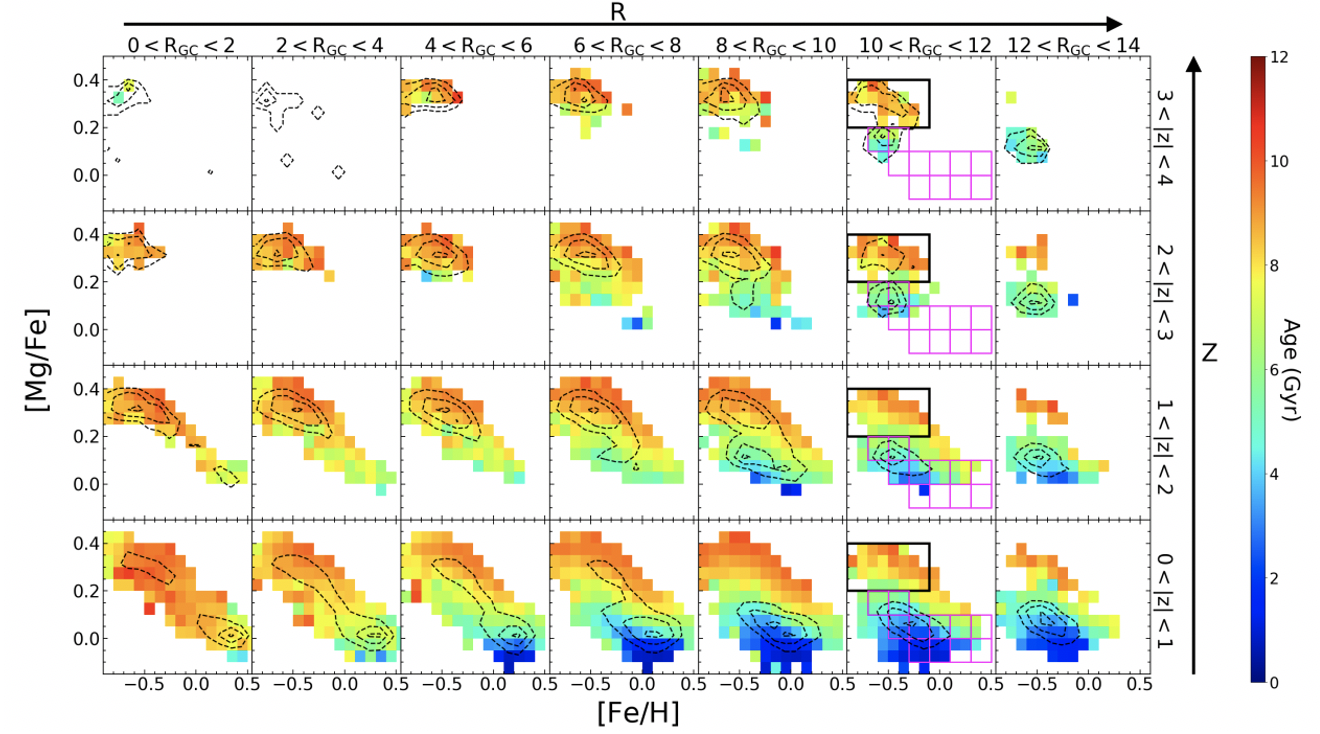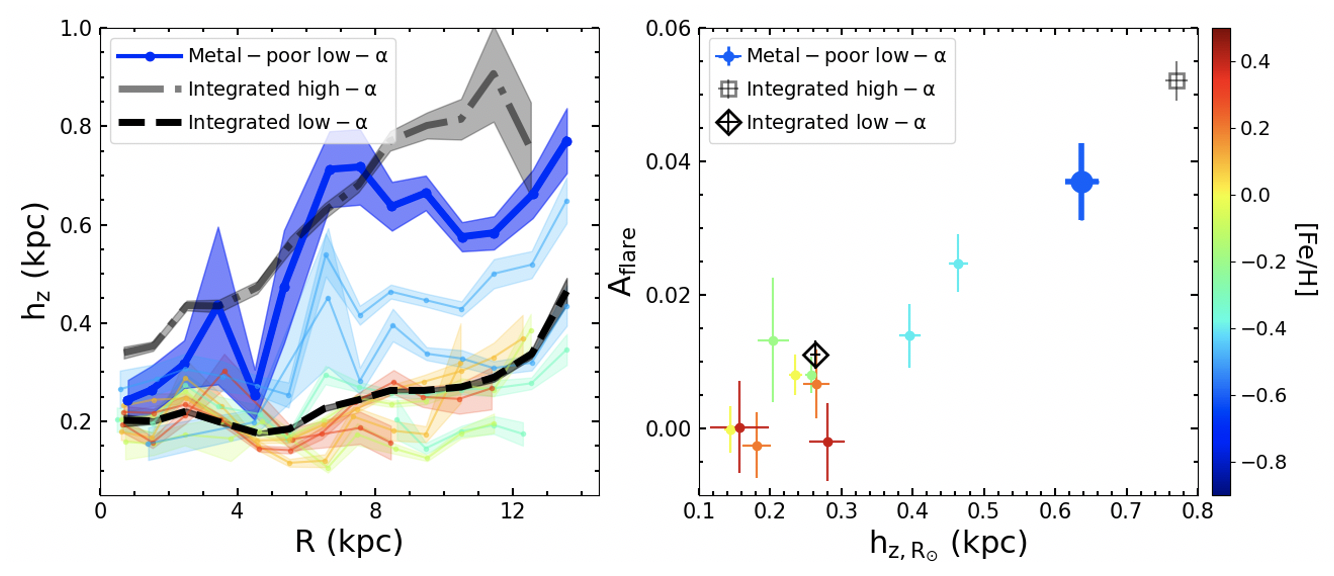中国西南天文研究所研究团队揭示银河系中隐藏的年轻厚盘结构
The Hidden Young Thick Disk Structure in the Milky Way
在浩瀚宇宙中,银河系是我们人类的 “家园星系”。从侧面看,它像一个中间厚、边缘薄的飞盘。银河系的盘状结构一直是天文学家关注的焦点,传统观点认为,银河系的盘由一个古老的厚盘和一个相对年轻的薄盘组成。但关于厚盘究竟如何形成,天文学家们一直争论不休。

图1.银河系基本结构示意图。
Figure 1. Schematic plot of the basic stellar structure of the Milky Way.
最近,一项由云南大学中国西南天文研究所团队完成的研究成果为我们揭开了银河系的新面纱,研究团队发现了银河系中一个此前未被充分认识的年轻厚盘结构,为我们理解银河系的形成与演化提供了全新视角。
此次研究,科研团队借助 APOGEE光谱巡测和盖亚天体测量数据,对银河系垂直银盘方向的结构展开深入研究,发现在距离银盘平面较远(高度|z|>3 kpc)且超出太阳银心半径(8<R<14 kpc)的区域,存在着两组具有不同年龄和 α 元素丰度特征的低金属丰度([Fe/H]~-0.6 dex)恒星。其中一组是我们熟悉的古老厚盘恒星,而另一组恒星的年龄明显更年轻,α 元素丰度也更低。两组恒星年龄相差至少27亿年。

图2.银河系恒星在年龄-[Mg/Fe]-[Fe/H]上的分布及其随半径和银盘高度的变化。
Figure 2. The age-[Mg/Fe]-[Fe/H] distribution of the Milky Way’s stars as a function of disk radius and height.
通过进一步分析,研究人员将银河系盘划分为多个单丰度星族,并精确测量了它们的标高(一种表征盘厚度的参数)。结果显示,这组年轻且 α 元素丰度较低的恒星,在盘的厚度及厚度随半径增长的趋势上,都比同样具有低 α 元素丰度但更富金属的星族更厚且厚度随半径增长更快,但与传统认知中的古老厚盘相似,虽然其径向分布更为延展。
这一发现有着重大意义,让我们对银河系的认识又向前迈进了重要一步。从银河系的演化历史来看,年轻厚盘的存在表明银河系至少经历了两次剧烈的恒星形成和盘结构由厚到薄的形成过程,这一过程很可能是由星系并和引起的。这挑战了传统的厚盘形成理论——如果厚盘是由长期动力学加热形成的,那么在年轻厚盘形成时,之前存在的薄盘也应该被加热,但实际观测并非如此。这说明,恒星诞生时的环境在决定盘的厚度方面起着关键作用。
该工作已在国际知名天文期刊《天体物理学杂志通讯》(ApJL)上发表:https://doi.org/10.3847/2041-8213/adccb7 。云南大学中国西南天文研究所连建辉副教授是文章第一作者,与厦门大学杜敏副教授为共同通讯作者,参与该研究的合作者包括厦门大学研究生卢帅、云南大学陈丙秋教授、美国犹他大学的Gail Zasowski副教授、上海交通大学李兆聿教授和研究生廖筱婕、国家天文台刘超研究员。该工作得到了国家重点研发计划和国家自然科学基金项目的资助。

图3.银河系单元素丰度星族的标高随半径的变化。图中的深蓝色曲线(左图)和数据点(右图)代表新发现的年轻厚盘结构。
Figure 3. The scale height as a function of radius for mono-abundance populations in the Milky Way. The young thick disk structure is shown in dark blue thickened curve (left panel) and data point (right panel).

In the vast universe, the Milky Way is our home galaxy. Seen from the side, it resembles a frisbee that is thick in the middle and thin at the edges. The disk structure of the Milky Way has always been the focus of astronomers' attention. The traditional view holds that the disk of the Milky Way consists of an ancient thick disk and a relatively young thin disk. However, astronomers have long debated how the thick disk was formed.
Recently, a research team of the Southwest Astronomical Institute of Yunnan University has unveiled a new aspect of the Milky Way, a young thick disk structure in the Milky Way that had not been fully recognized before, providing a brand-new perspective for understanding the formation and evolution of the Milky Way.
In this study, the team utilized data from the Apache Point Observatory Galactic Evolution Experiment (APOGEE) spectroscopic survey and Gaia astrometric data to conduct an in-depth study of the vertical structure of the Milky Way. The researchers found that in the region far from the plane of the Galactic disk (|z|>3 kpc) and beyond the solar galactocentric radius (8<R<14 kpc), there are two groups of stars with distinctive age and α - element abundance. One group consists of the canonical ancient thick disk stars, while the other group has significantly younger ages and lower α - element abundances. The age difference between the two groups of stars is at least 2.7 billion years.
Through further analysis, the researchers divided the Galactic disk into multiple mono- abundance stellar populations and accurately measured their scale heights (a parameter characterizing the thickness of the disk). The results show that, in terms of the disk thickness and its variation as a function of radius, this group of young stars with low α-element abundances is comparable to the traditional ancient thick disk, but distinctive from other low-α disk populations.
This discovery is of great significance that greatly advanced our understanding of the Milky Way’s disk formation and evolution. The existence of the young thick disk, in addition to the well-know old thick disk, indicates that the Milky Way has experienced at least two phases of intense star formation and ‘upside-down’ disk formation, which are likely caused by galaxy mergers. This challenges the traditional thick disk formation theory. If the thick disk was formed by long-term dynamical heating, then when the young thick disk was formed, the previously existing thin disk should also have been heated, which is not the case in actual observations. This shows that the environment in which stars are born plays a more important role in determining the thickness of the disk.
This work has been published in The Astrophysical Journal Letters (ApJL): https://doi.org/10.3847/2041-8213/adccb7. Assoc. Prof. Jianhui Lian from the Southwest Astronomical Institute of Yunnan University is the first author, together with Assoc. Prof. Min Du from Xiamen University as the corresponding authors of the article. The collaborators involved in this research include graduate student Shuai Lu from Xiamen University, Prof. Bingqiu Chen from Yunnan University, Assoc. Prof. Gail Zasowski from the University of Utah, Prof. Zhaoyu Li and graduate student Xiaojie Liao from Shanghai Jiao Tong University, and Researcher Chao Liu from the National Astronomical Observatories of China. This work is supported by the grant from National Natural Science Foundation of China, National Key R&D Program of China.
